Related Research Articles

Kuching, officially the City of Kuching, is the capital and the most populous city in the state of Sarawak in Malaysia. It is also the capital of Kuching Division. The city is on the Sarawak River at the southwest tip of Sarawak on the island of Borneo and covers an area of 431 km2 (166 sq mi) with a population about 165,642 in the Kuching North administrative region and 159,490 in the Kuching South administrative region—a total of 325,132 people.
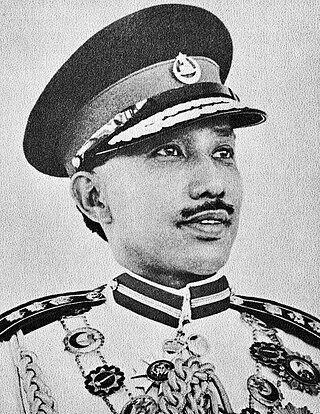
Omar Ali Saifuddien Sa'adul Khairi Waddien was the 28th Sultan of Brunei, reigning from 1950 until his abdication in 1967 to his oldest son, Hassanal Bolkiah.

Omar Ali Saifuddin II was the 23rd Sultan of Brunei. During his reign, Western powers such as the United Kingdom and the United States visited the country. His reign saw the British adventurer James Brooke becoming the White Rajah of Sarawak.
Omar Ali Saifuddin I ibni Muhammad Alauddin, also known as Al-Marhum Makam Besar, was the 18th Sultan of Brunei and the second son of Sultan Muhammad Alauddin. He was regarded as one of the longest-serving sultans and was renowned for his wise leadership and just rule, merely following his father-in-law, Sultan Hussin Kamaluddin. In fact, he received helpful knowledge, counsel, and experience from his father-in-law when he was still alive during his reigning period.

Ahmad Tajuddin Akhazul Khairi Waddien was the 27th Sultan of Brunei from 1924 until his death in 1950. He was succeeded by his younger brother Sultan Omar Ali Saifuddien III.

Abdul Momin ibni Abdul Wahab was the 24th Sultan of Brunei from 1852 until his death in 1885.

Hashim Jalilul Alam Aqamaddin was the 25th Sultan of Brunei from 1885 to 1906. Pengiran Anak Hashim or Hashim Jalilul was a prominent and controversial figure in Bruneian history. Many Western visitors' narrative painted him and his surroundings in a bad light, which was consistent with the idea that Brunei was a decaying monarchy at the time.

The Raj of Sarawak, also the Kingdom of Sarawak or State of Sarawak, located in the northwestern part of the island of Borneo, was an independent state founded in 1841, in a treaty of protection with the United Kingdom starting from 1888. It was established from a series of land concessions acquired by an Englishman, James Brooke, from the Sultan of the Bruneian Empire. Sarawak was recognised as an independent sovereign state by the United States in 1850 and by the United Kingdom in 1864. The Kingdom is now the Malaysian state of Sarawak.
Syarif Masahor bin Syarif Hassan, also written as Sharif Masahor was a famous Malay rebel of Hadhrami descent in Sarikei, Sarawak state, Malaysia during the Brooke White Rajahs era in that state.

The History of Sarawak can be traced as far as 40,000 years ago to the paleolithic period where the earliest evidence of human settlement is found in the Niah caves. A series of Chinese ceramics dated from the 8th to 13th century AD was uncovered at the archeological site of Santubong. The coastal regions of Sarawak came under the influence of the Bruneian Empire in the 16th century. In 1839, James Brooke, a British explorer, first arrived in Sarawak. Sarawak was later governed by the Brooke family between 1841 and 1946. During World War II, it was occupied by the Japanese for three years. After the war, the last White Rajah, Charles Vyner Brooke, ceded Sarawak to Britain, and in 1946 it became a British Crown Colony. On 22 July 1963, Sarawak was granted self-government by the British. Following this, it became one of the founding members of the Federation of Malaysia, established on 16 September 1963. However, the federation was opposed by Indonesia, and this led to the three-year Indonesia–Malaysia confrontation. From 1960 to 1990, Sarawak experienced a communist insurgency.

The Royal Brunei Mausoleum is a Royal Mausoleum of Brunei located at Jalan Tutong, Bandar Seri Begawan, Brunei. The Mausoleum is the main resting place and burial ground for several Sultans of Brunei and members of the Royal Family. The Royal Mausoleum was opened during the reign of Sultan Omar 'Ali Saifuddin I who later became the first monarch to be buried in the Mausoleum when he died in 1795.
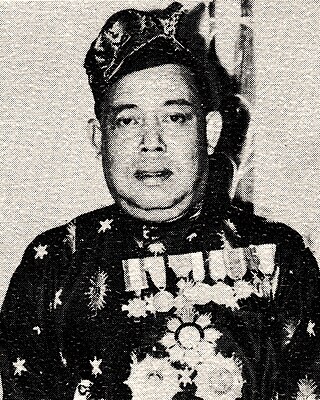
Pengiran Anak Haji Mohamed Alam, sometimes spelled Muhammad Alam, was a nobleman, magistrate and politician who became the fourth Speaker of the Brunei Legislative Council from 1971 until 1974 and Chief of Jabatan Adat Istiadat Negara from 1954 to 1981. He is the father of Pengiran Anak Saleha, the queen consort of Hassanal Bolkiah, the current Sultan of Brunei. He was also a maternal grandfather of Al-Muhtadee Billah, the Crown Prince.
Ibrahim Ali Omar Shah Ibni Muhammad Hassan, also known as Sultan Tengah or Raja Tengah, was the first and only Sultan of the Sultanate of Sarawak. He is the son of Sultan Muhammad Hasan of Brunei.

The Sultanate of Sarawak was a Malay kingdom, located in present-day Kuching Division, Sarawak. The kingdom was founded in 1599, after the conquest of the preceding Santubong Kingdom and the later Sultanate of Brunei.

Edge of the World is a 2021 adventure drama film directed by Michael Haussman and starring Jonathan Rhys Meyers as the British soldier and adventurer James Brooke (1803–1868), the first White Rajah of Sarawak. The film also features Atiqah Hasiholan, Dominic Monaghan, Hannah New, and Josie Ho. The script was written by Rob Allyn, who also produced the film. Edge of the World is a co-production between Malaysia, China, the US and the UK.
Muhammad Alam ibnu Muhammad Kanzul Alam was the self-proclaimed 22nd Sultan of Brunei. Due to his tough and strict attitude, he was given the Malay nicknames Raja Api and Sultan Marak Berapi. Despite being perceived as a fragile and progressively protective kingdom, Brunei managed to hold onto its lands under his rule, which stretched from Tanjong Datu in Sarawak to Kimanis in Sabah.
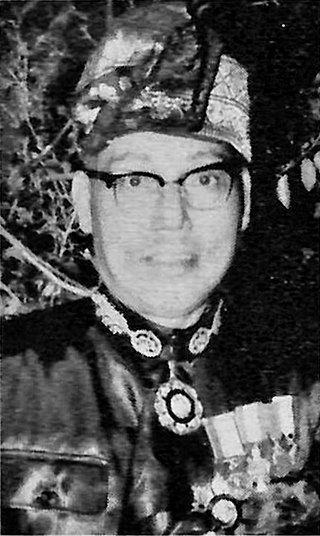
Pengiran Anak Hashim, also commonly known as Pengiran Muda Hashim and P. M. Hashim, was a Bruneian nobleman and politician who formerly held several high-ranking positions which included being a member of the Privy Council, Legislative Council, and the Islamic Religious Council.
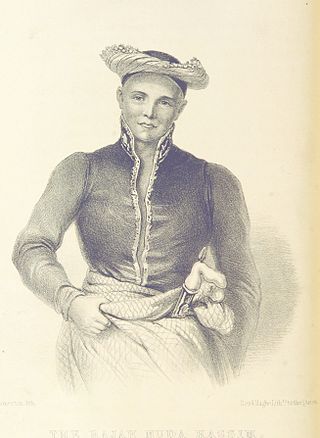
Pengiran Mohammad Salleh ibnu Pengiran Sharifuddin (1790s–1858) or commonly referred to by his title Pengiran Indera Mahkota, was a Bruneian nobleman and politician who was governor of Sarawak in 1827. In the region that is now part of Sarawak, he founded the city of Kuching in 1827.
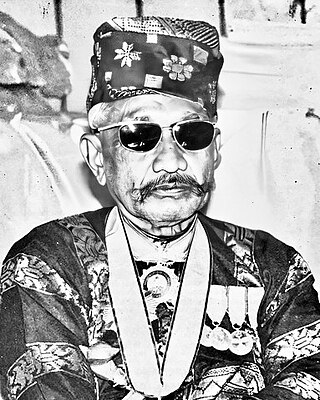
Pengiran Anak Haji Khamis, also referred to as Pengiran Anak Kamis, was a Bruneian nobleman and politician who formerly held several high-ranking positions which included being a member of the Privy Council, and the Islamic Religious Council. He is the non-gahara son of Sultan Hashim Jalilul Alam Aqamaddin, therefore does not carry the title Prince.
Datu Patinggi Abang Ali bin Abang Amir was a key figure in the Sarawak Malays' resistance to the Brunei Empire, which they waged throughout Pengiran Indera Mahkota and Raja Muda Hashim's reign in the 1830s. He became one of the first supporters of the Brooke Raj and was hailed as Sarawak's first national hero. An important part in the 1830s uprising against Bruneian authority was played by him. In an endeavor to oppose Brunei's attempts to subjugate Sarawak through local leaders, he was known to be a fearless and resolute leader. Brooke then took Ali as an aide-de-camp after the Sarawak dispute ended.
References
- 1 2 Singh, D. S. Ranjit (26 November 2019). The Indonesia–Malaysia Dispute Concerning Sovereignty over Sipadan and Ligitan Islands: Historical Antecedents and the International Court of Justice Judgment. ISEAS-Yusof Ishak Institute. p. 30. ISBN 978-981-4843-64-5.
- ↑ Hussainmiya, Bachamiya Abdul (2006). Brunei: Revival of 1906 : a Popular History. Brunei Press. p. 6. ISBN 978-99917-32-15-2.
- ↑ Chang, Pat Foh (1995). The Land of Freedom Fighters. Ministry of Social Development.
- ↑ Chang, Pat Foh (1999). Legends & History of Sarawak. Chang Pat Foh. p. 30. ISBN 978-983-9475-06-7.
- 1 2 3 History, Borneo (29 December 2014). "Borneo History: Raja Muda Hashim". Borneo History. Retrieved 23 July 2023.
- ↑ Gin, Ooi Keat (14 December 2015). Brunei – History, Islam, Society and Contemporary Issues. Routledge. ISBN 978-1-317-65997-6.
- ↑ Singh, D. S. Ranjit (26 November 2019). The Indonesia-Malaysia Dispute Concerning Sovereignty over Sipadan and Ligitan Islands: Historical Antecedents and the International Court of Justice Judgment. ISEAS-Yusof Ishak Institute. p. 30. ISBN 978-981-4843-64-5.
- ↑ Windt, Harry De (1 August 2022). On the Equator. DigiCat.
- 1 2 Prosiding Kolokium 35 Tahun Sarawak Bersama Malaysia Dan Esei Pilihan Yang Berlangsung Di Kota Samarahan, Sarawak 22 Ogos 1998. Fakulti Sains Sosial, Universiti Malaysia Sarawak. 1999. p. 27. ISBN 978-983-9151-06-0.
- ↑ Vienne, Marie-Sybille de (9 March 2015). Brunei: From the Age of Commerce to the 21st Century. NUS Press. p. 79. ISBN 978-9971-69-818-8.
- 1 2 Sidhu, Jatswan S. (22 December 2009). Historical Dictionary of Brunei Darussalam. Scarecrow Press. p. 97. ISBN 978-0-8108-7078-9.
- ↑ Brown, Donald Edward (1970). Brunei: The Structure and History of a Bornean Malay Sultanate. Brunei Museum. p. 54.
- ↑ Hale, Christopher (21 March 2023). A Brief History of Singapore and Malaysia: Multiculturalism and Prosperity: The Shared History of Two Southeast Asian Tigers. Tuttle Publishing. ISBN 978-1-4629-2393-9.
- ↑ Brunei, Muzium (1974). The Brunei Museum Journal. Brunei Museum. p. 159.
- ↑ Sarawak (1963). The Sarawak Government Gazette. p. 151.